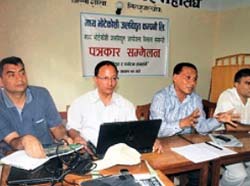

Promoters unveil tourism development plan

Chautara: Amid concerns about the world’s popular white-water rafting being threatened by the planned 102MW Middle Bhotekoshi Hydropower Project (MBHP) in Sindhupalchowk, the project on Thursday unveiled plans to expedite inclusive tourism projects side-by-side to save its thrilling appeal among visitors. Bhote Koshi is the steepest river rafted in Nepal with a gradient of 15 minute per km.
The project plans to construct an international standard rafting centre, museum and meeting hall, among others, to promote tourism in the area. Promoted by the developers of Chilime Hydropower Project, the project has already signed the Power Purchase Agreement with the Nepal Electricity Authority. The four-year project is scheduled to begin in 2013.
Kulman Ghising, Chairman of MBHP, said they have planned to add more facilities for the 21km river rafting, stretching from Basheri to Sunkoshi dam, and 35km stretch from Sunkoshi powerhouse to Dolalghat.
“We are focused on promoting ecotourism in project areas,” he said, adding that Rs 100 million will be invested annually for local development.
At present, there are around seven resorts and over 30 rafting companies. Tourism entrepreneurs said the popular river attracts a huge number of domestic and foreign visitors annually. Ghising said extensive development of the river for rafting could prolong visitors stay.
MBHP will produce 550 million units of power and is estimated to cost Rs 14.50 billion. Of the total funding, the Employees’ Provident Fund has agreed to lend 50 percent of the project cost. Ghising said promoters will have 51 percent investment shares and remaining from the public.
Amid complaints from tourism entrepreneurs and some locals that the project would put the popular white-water rafting at risk, Ghising said if local investors were not encouraged for power development, foreign investors would be discouraged. “Bhotekhosi will contribute Rs 30 billion annually to the country’s economy and its annual revenue to the government stands at Rs 600 million,” he said.
The worrying factor for the travel trade sector is that the project has proposed to build a dam at Chaku along the Araniko highway and a power house at Jambu (7-km downstream), which will reduce water volume drastically and affect rafting. Instead they have proposed to reduce the project capacity and let the river flow from a few kilometers upward so that it won’t affect rafting.
Tourism entrepreneurs have submitted memoranda to the government several times, against the project and have asked to protect the world’s appealing tourism product.
However, the project officials said if they consider entrepreneurs’ recommendation, only half of the estimated energy will be produced but the project cost will be the same.
source: The Kathmandu Post,27 July 2012








